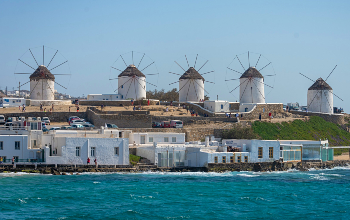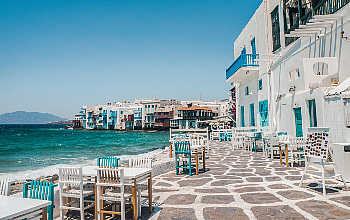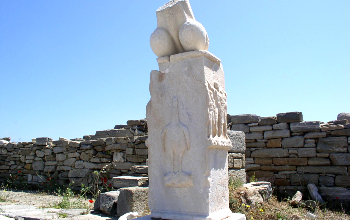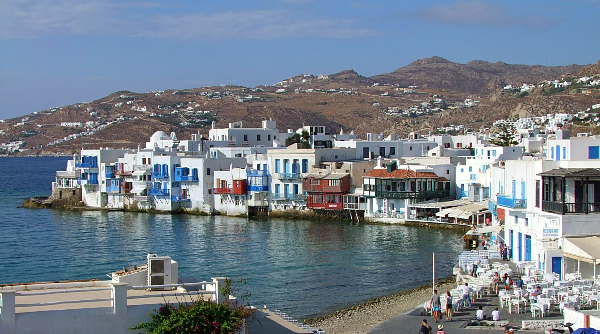Greece’s most famous cosmopolitan island is a whitewashed paradise in the heart of the Cyclades. According to mythology, Mykonos was formed from the petrified bodies of giants killed by Hercules, and the island took its name from the grandson of Apollo — Mykonos. It is known for its dry, windy climate, sandy beaches, and world-famous nightlife, and is a fascinating destination where glamour meets simplicity. Whether you are an entertainment junkie looking for a really good time or a visitor who wishes to explore the island’s history and tradition, Mykonos will meet your expectations.
The capital town of Hóra is widespread and visitors find it spellbinding. Stroll its narrow marble streets and admire whitewashed houses with colorful doors and window frames, bougainvillea trees in purple bloom, and hidden churches. Wander the busy pedestrian shopping streets, the most glamorous of which is Matoyánni Street, lined with brand-name stores, charming cafés, and stylish restaurants. Pay a visit to the church of Panayia Paraportiani, the Townhall, and the castle situated above the harbor. And don’t forget to visit the Archaeological, Folklore, and Maritime Museums to take in a little history.

Windmills of Mykonos
Venture to see the iconic windmills of Mykonos. They can be seen from every angle of the island and are easily identifiable due to their silhouette. There are 16 windmills in total, seven are positioned on the landmark hill in Chora, one of which is now a museum. Most were built by the Venetians between the 16th and early 20th centuries, for the purpose of milling wheat. Today, they represent an extremely popular place for visitors, especially those interested in photography.
Soak up the atmosphere along the lively waterfront and admire a fleet of fishing boats casting colorful reflections in the azure waters. This is where you will find the Kazárma building, which served as accommodations for the soldiers of Manto Mavrogenous, a heroine of the Greek Revolution. The first floor served as her personal residence.
While you’re out strolling, don’t be surprised if you come across the official mascot of Mykonos, which is nothing other than a… pelican! Pétros the Pelican was found by a fisherman after a storm in 1954, and eventually became the locals’ companion. When he died, the grief for his loss was so deep that a replacement was soon found. In honor of Pétros, the locals have established a long tradition of pelicans wandering around the waterfront as an essential part of everyday life. So, whatever you do, don’t forget to take a picture with the successor of the famous pelican Pétros!

Little Venice
One of the most scenic corners of the island is Alefkántra or Little Venice, an 18th-century district, dominated by grand captains’ mansions with colorful balconies and stylish windows. With balconies perched over the sea, pictures of the famous Italian city spring to mind. Relax at a waterfront café and admire the view.
Along the southern coast, visitors will find a great selection of beaches where parties keep the crowds rocking day and night. Paradise and Super Paradise may already be familiar to you. Órnos and Psaroú are favorite spots for families. To soak up the sun from a sun lounger, visit Platis Yalós. However, if you are looking for a serene beach as a place to unwind, pick one on the northern coast of the island, like Ayia Ánna, Houlákia, Kápari, Agrári, and Ayios Stéfanos.
The island is a paradise for water sports enthusiasts and is a great choice for windsurfing. However, the most secluded beaches — Kórfos, Fteliá, Meyáli Ámmos, and Kalafátisare — are best for this and also feature surfing lessons. Play tennis or mini golf at Ayios Stéfanos, beach volleyball at Ayia Anna, or try sea parachuting or jet skiing at Eliá or Kalafátis. Diving fans can do a little exploration of the underwater magic of Mykonos. September is thought to be the best month for diving, as the water is warm and visibility is good down at the seabed. Visitors will discover several diving centers (some of which offer snorkeling lessons as well) and stores specializing in diving equipment. Explore the island by boat and tour the nearby islets, or perhaps go fishing.

Delos ruins
If you find yourself in the region, take the opportunity to explore the tiny archaeological gem of Delos, just a short boat trip away. Delos was a sacred island in ancient times, and according to mythology was the birthplace of the twin gods Apollo and Artemis.
While visiting Mykonos, don’t forget to enjoy local cuisine including the island’s trademark of pepper flavored kopanistí, a soft cheese seasoned with pepper. Try it as a topping on a round rusk spread with grated tomato, a favorite local mezés (appetizer). Meat eaters can sample “loúzes” (cooked pork filet with spices) and tasty local sausages sprinkled with pepper and local oregano that has been sun-dried. To finish your meal, sample two local delicious pastries — honey pie and amigdalotá (small round cakes with ground almond, rosewater, and caster sugar).
During the summer months (especially in August), Mykonos is one of the most crowded islands in Greece, so be sure to plan your holidays far in advance. To escape the crowds, visit the island during spring or fall.
Source: Visit Greece
Photo Credits:
Lead – Laborratte on Pixabay
Little Venice – Johnny Africa on Unsplash
Windmills – Spalla67 on Pixabay
Delos ruins – Zebulon72 on Pixabay


